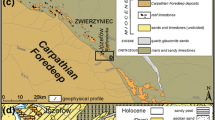Abstract
Field experimental seismic sounding permitted us to obtain optimal shallow seismic reflection sounding parameters. In process of data processing, we obtained a high-qualitative shallow seismic reflection sounding profile by using the techniques such as filtering, edition surgical blanking, prediction deconvolution, fitting static correlation of first arrival time, and velocity analysis. Comprehensive analysis on the information of reflection wave groups along the seismic sounding profile and the stratigraphic and neogeochronological data obtained from many drills near the sounding line reveals that the upper termination of the detected fault zone is located at depth of 75–80 m, in the Middle Pleistocene deposits dated to be about 220 ka BP. The continuity, discontinuity, increasing and decreasing amount of reflection wave groups and change of their configurations, in combination with geological columns of drills, permitted us to know that the width of upper termination of the fault zone is 100 m. It can be inferred from the variation of number of reflection wave groups along the profile that the scarp of hidden fault is 200 m wide and the fault is a synsedimentary active fault in the Early Pleistocene and the early stage of Middle Pleistocene. No tectonic movement, which offset the covering deposits, had occurred since the late stage of Middle Pleistocene.
Similar content being viewed by others
References
GU Meng-lin, LIU Bao-jin, ZHAO Cheng-bin, et al. 2000. Study on coupling between deep and shallow structures of Xingtai area and some significant questions [J]. Acta Seismologica Sinica, 13(4): 413–423.
LI Jian-hua, HAO Shu-jian, HU Yu-tai, et al. 1998. A study on activity of the seismogenic fault for the Tangshan earthquake of 1976 [J]. Seismology and Geology, 20(1): 27–33 (in Chinese).
LIU Jia-qi, LIU Qiang. 2000. Quaternary stratigraphy in China [J]. Quaternary Sciences, 20(2): 129–141 (in Chinese).
MIN Long-rui, CHI Zhen-qing. 2000. Discussion on plans of dividing Quaternary to series in China [J]. Quaternary Sciences, 20(2): 101–107 (in Chinese).
XIANG Hong-fa, WANG Xue-chao, GUO Shun-min, et al. 2000. Integrated survey and investigation on the Quaternary activity of the Liaocheng-Lankao buried fault [J]. Seismology and Geology, 22(4): 351–359 (in Chinese).
XU Xi-wei, WU Wei-min, ZHANG Xian-kang, et al. 2002. New Structure Movement and Earthquake Around the Capital Region [M]. Beijing: Science Press, 135–197 (in Chinese).
ZHAO Cheng-bin, SUN Zhen-guo, GU Meng-lin, et al. 2001. Prospecting and study on shallow crust structure in Manas earthquake area [J]. Chinese J Geophys, 44(1): 54–63 (in Chinese).
Author information
Authors and Affiliations
Additional information
Foundation item: A High-new Technique Project by State Development and Planning Commission of China (2001977).
About this article
Cite this article
Yang, Xp., Li, Dq., Zhao, Cb. et al. The movement age of hidden fault and analysis on width of its effect zone from shallow seismic sounding and drilling data. Acta Seismologica Sinica 17 (Suppl 1), 94–102 (2004). https://doi.org/10.1007/s11589-004-0071-8
Received:
Revised:
Accepted:
Issue Date:
DOI: https://doi.org/10.1007/s11589-004-0071-8




